Inscribed double-sided stele, containing a catalogue of dowries documented on Side A

This inscription of the 3rd century BC constitutes a rare find that bears witness to the continuity through the ages of a living tradition on the Cyclades (and beyond) that lasted well into the 17th century, as is also corroborated by the handwritten dowry agreement from Mykonos that accompanies this stele.
The inscription is a catalogue of agreements (engagements) between the future husband of a maiden and her “master”, who was most often her father (nos. 1, 2, 3, 5, 8, 9, 10, 13) or her brother (no. 6) or other relative (no. 7) for the purpose of marriage. The abbreviations after the proper names, such as Ar., An., My., etc., are most likely patronyms, while, according to others, they are demotics (indicating membership of a deme). The verb ἐγγυάω or ἐνεγγυάω (γυναῖκά τινι), namely “to have a woman plighted” signifies the betrothal. The agreement prior to the marriage, which could take place in the presence of witnesses, was necessarily accompanied by a financial transaction, the provision of a dowry.
Dowries consisted of money, movable goods and, in this case, clothing, dwellings and slaves. In the inscription from Mykonos, the value of each dowry in money and clothing ranges between 700 (no. 4) and 14,406 drachms (no. 2).